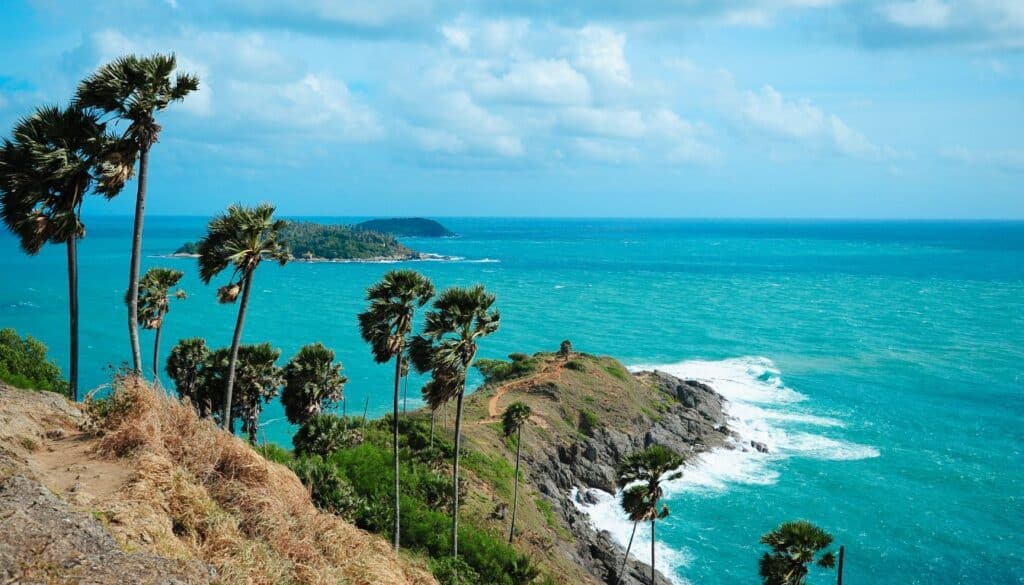When Is The Best Time To Visit Thailand?
Thailand is a tropical paradise that attracts travelers from around the world with its stunning beaches, vibrant cities, and rich cultural heritage. But when is the best time to visit Thailand?
Understanding Thailand’s climate and seasons can help you plan your trip for optimal weather and unforgettable experiences.
Thailand, unlike Western countries, has only two distinct seasons: the dry season and the rainy season, also known as the monsoon season.
The dry season, also known as the high season, is generally considered the best time to visit. However, there are regional variations in climate across Thailand.
Also, think about specific events like the burning season in Chiang Mai, where there’s a lot of smog in this area, and not ideal for visiting.
So it’s important to dive deeper and look at specific factors when determining the ideal period for your visit.
I’ve been going to Thailand every year since 2010 and I’ve already been there in every single month of the year and personally, I prefer to go outside of the high-season.
Mainly because my wife and I get way better hotel deals and keep in mind that with rainy season, it doesn’t rain all day, every day. I know you might think that. But during the rainy season it usually only rains once or twice a day for 1 to 2 hours.
In this article, I will explain Thailand’s climate and seasons, discuss the best time to visit Thailand based on the weather, and highlight the advantages and disadvantages for traveling during specific periods.
Whether you’re seeking a beach vacation, visiting cultural festivals, or prefer a more budget-friendly trip, this article will help you make the most of your time in Thailand.

Key Takeaways:
- The best time to visit Thailand is during the dry season, which runs from November to early April.
- Thailand’s regional weather patterns vary, so it’s important to consider factors like temperature and rainfall when planning your visit.
- Visiting during the peak tourist season offers optimal weather conditions but means larger crowds and higher prices.
- The low season, which coincides with the rainy season, offers discounted prices and less tourists, but also brings the possibility of rain and disruption of outdoor activities.
- Shoulder seasons, just before and after the peak season, can provide a balance between cost savings and good weather but may come with a weather risk due to transitioning seasons.
Understanding Thailand’s Climate and Seasons
Thailand, located in Southeast Asia, experiences a tropical climate characterized by two main seasons: the dry season and the rainy season. Understanding the climate and seasonal variations in Thailand can greatly influence your travel plans and ensure you make the most of your vacation.
Key Climate Patterns Across Thai Regions
Thailand’s climate exhibits regional variations across different parts of the country. In the northern regions, such as Chiang Mai, temperatures are generally cooler, especially during the winter months.
My wife has a house in a Northern city called Phayao and during the winter months, it gets 30 degrees during the day and cools down to 15 degrees at night.
And believe it or not, I even slept with my clothes on in some occasions.
On the west coast, which includes popular destinations like Phuket and Krabi, the weather is optimal for beach vacations during the dry season.
It’s important to consider these climate patterns when planning your itinerary to ensure you visit the regions with the most favorable weather conditions for your desired activities.
Navigating Thailand’s Seasonal Variations for Optimal Travel
The two main seasons in Thailand, the dry season and the rainy season, each have their pros and cons.
The dry season, which occurs from November to early April, is generally considered the best time to visit. During this period, you can expect pleasant temperatures, little rainfall, and optimal conditions for outdoor activities and exploring popular tourist attractions.
By the way, spending your Christmas holidays in a country like Thailand is quite the experience and I can highly recommend it.
On the other hand, the rainy season, which typically lasts from May to October, can be a more challenging time for travelers.
Heavy rainfall and increased humidity can disrupt outdoor activities and beach vacations. However, there are also advantages to visiting during this low season, such as fewer tourists, lower prices for flights and accommodations, and the opportunity to experience Thailand’s beautiful green landscapes.
The Impact of Year-Round Temperatures on Your Vacation
Thailand experiences relatively high temperatures throughout the year due to its tropical location. The average annual temperature hovers around 27 to 30 degrees Celsius (80 to 86 degrees Fahrenheit). While the dry season offers more consistently pleasant temperatures, the year-round warmth allows for a wide range of activities regardless of the season.
| Season | Temperature Range | Key Factors |
|---|---|---|
| Dry Season | 25-32°C (77-90°F) | Low rainfall, pleasant temperatures, optimal for outdoor activities |
| Rainy Season | 24-30°C (75-86°F) | High rainfall, increased humidity, lush green landscapes |
Regardless of the season, it’s important to pack appropriate clothing and sunscreen to stay comfortable under Thailand’s year-round warmth and tropical sun.

When Is The Best Time To Visit Thailand?
The best time to visit Thailand is during the cool and dry season, which typically runs from November to early April. This is the peak tourist season, with pleasant temperatures and little rainfall.
The weather during this period is ideal for outdoor activities, beach vacations, and exploring popular tourist attractions. Whether you want to swim, sunbathe, or take part in water sports, the dry season offers the perfect conditions for enjoying Thailand’s stunning beaches and crystal-clear waters.
Exploring the country’s rich cultural heritage and vibrant cities is also best done during this time, as the weather is comfortable for sightseeing and outdoor adventures. From Bangkok’s bustling markets to the ancient temples of Chiang Mai, you can fully immerse yourself in Thailand’s unique culture.
It’s important to note, however, that the peak tourist season is also the busiest time of year. Expect larger crowds at popular tourist sites and attractions, as well as higher prices for your hotel and transportation.
If you prefer a more relaxed and budget-friendly experience, you may consider visiting during the shoulder seasons or low season. The shoulder seasons of late October to November and late April to May offer slightly lower prices and fewer crowds compared to the peak season, while still providing favorable weather conditions.
The low season, which typically runs from May to October, is characterized by higher humidity and a greater chance of rainfall. While this may not be the most popular time to visit, it does have its advantages. The lower number of tourists means more peaceful and less crowded attractions and accommodations.
Additionally, prices for flights and accommodations tend to be lower during the low season.
And a fun bonus is that a lot of hotels will give you even free upgrades to better rooms. My wife Saengduan and I had this quite often, that we booked a room and got a free upgrade on arrival because the hotels had more than enough rooms left.
Whether you choose to visit during the peak season, shoulder seasons, or low season, Thailand offers a wide range of experiences and attractions to suit every traveler’s preferences. Plan your trip accordingly and make the most of your time in this incredible destination.
Exploring Regional Weather Differences in Thailand
Thailand is a diverse country with a range of climate variations across its different regions. The weather patterns can significantly impact your travel experience, so it’s important to know the regional differences when planning your trip.
Best Places to Visit During Peak Tourist Season
During the peak tourist season, which is typically from November to early April, some regions in Thailand offer the best weather for popular activities. Here are a few destinations worth considering:
- Phuket: This island on the west coast of Thailand is known for its pristine beaches and crystal-clear waters. The peak season offers ideal conditions for sunbathing, swimming, and snorkeling.
- Krabi: Another beautiful province on the west coast, Krabi is famous for its dramatic limestone cliffs and stunning islands. Here you can enjoy activities like rock climbing, island-hopping, and exploring the stunning Railay Beach.
- Bangkok: As Thailand’s capital city, Bangkok is a year-round tourist destination. However, during the peak season, the weather is more favorable for exploring the city’s temples, shopping districts, lively street markets, and let’s not forget the nightlife.
Off-Peak Travel Benefits in Thailand’s Less-Visited Areas
While the peak season is undoubtedly a great time to visit popular tourist destinations, there are advantages to exploring Thailand’s less visited areas during the off-peak season. Here are some off-the-beaten-path regions to consider:
- Chiang Mai: Located in the mountain region of northern Thailand, Chiang Mai offers a cooler climate, especially during the winter months. This makes it an excellent time to visit for exploring temples, experiencing traditional festivals, and immersing yourself in the local culture.
- Northeast Thailand: Often overlooked by tourists, the northeastern region of Thailand, also known as Isan, offers a unique cultural experience. This area has a distinct cuisine, ancient ruins, and traditional festivals that can be enjoyed with fewer crowds during the off-peak season.
- East Coast Islands: The east coast of Thailand, including islands like Koh Samet and Koh Chang, offers stunning beaches and a more laid-back atmosphere compared to the popular west coast islands. Traveling during the off-peak season allows you to enjoy the natural beauty of these islands without the crowds.
By considering the regional weather differences in Thailand and exploring both peak and off-peak travel options, you can tailor your trip to match your preferences and enjoy a memorable vacation.
Monthly Breakdown: Ideal Times for Specific Activities
If you have specific activities or interests in mind for your trip to Thailand, it’s important to know the best months to experience them. Whether you’re an avid diver, snorkeler, or cultural enthusiast, timing your visit can greatly enhance your overall experience.
Diving and Snorkeling: Best Months for Underwater Adventures
Thailand boasts an array of stunning dive sites and vibrant marine life, making it a paradise for underwater exploration.
The best months for diving and snorkeling are typically from November to February. During this period, the oceans are clear and calm, providing excellent visibility for exploring the breathtaking coral reefs and encountering colorful tropical fish. Whether you’re a seasoned diver or a beginner, these months offer ideal conditions for unforgettable underwater adventures.
I can highly recommend to go diving in Phuket.
Festivals and Cultural Events: Timing Your Visit Perfectly
Thailand is renowned for its festivals and cultural events, which offer a captivating glimpse into the country’s rich heritage.
Timing your visit to coincide with these festivities can add an extra layer of excitement and immerse you in the local traditions.
Some of the most popular festivals in Thailand include Chinese New Year, celebrated in late January or early February, and Songkran, the Thai New Year, which takes place in mid-April.
These festivals are marked by colorful parades, traditional performances, and lively celebrations, creating a truly memorable experience for visitors.
When Is The Worst Time To Visit Thailand?
While Thailand is a fantastic travel destination throughout the year, there are certain periods that may not be ideal for everyone. The worst time to visit Thailand is during the rainy season, which typically lasts from May to October. The heavy rainfall can disrupt outdoor activities and beach vacations, and some areas may be prone to flooding. Additionally, the humidity and heat during this time can be uncomfortable for some travelers.
| Rainy Season in Thailand |
|---|
| Period: May to October |
| Disadvantages: |
|
Pros and Cons of Visiting During the Rainy Season
While the rainy season in Thailand may not be the most popular time to visit, it does have its advantages. Here are the pros and cons of traveling during the low season in Thailand:
- Pros:
- Fewer tourists lead to more peaceful and less crowded attractions and accommodations.
- Prices for flights and accommodations tend to be lower, making it a more budget-friendly time to visit.
- Disadvantages:
- Increased likelihood of rain which can disrupt outdoor activities and beach vacations.
- Potential for the disruption of outdoor activities due to heavy rainfall or flooding.

When Is the Cheapest Time To Visit Thailand?
For budget-conscious travelers, the cheapest time to visit Thailand is during the low season, which is typically from July to September. During this period, you can find discounted prices on flights, accommodations, and tours. However, it’s important to note that the low season coincides with the rainy season, so you should be prepared for the possibility of rain and plan indoor activities accordingly.
Traveling Strategically: Shoulder Seasons and Low Season Advantages
Traveling during the shoulder seasons, which are the periods just before and after the peak tourist season, can offer several advantages for visitors to Thailand. While there is a potential weather risk during this time, the benefits outweigh the potential drawbacks.
Cost Savings and Fewer Crowds: Is It Worth the Weather Risk?
One of the main advantages of traveling during shoulder seasons in Thailand is the opportunity to save money. As demand decreases during this time, prices for flights, accommodations, and attractions often drop significantly. This can make it an excellent opportunity for budget-conscious travelers to explore Thailand while keeping their expenses low.
Additionally, traveling during shoulder seasons allows visitors to experience fewer crowds at popular tourist destinations. This means shorter lines, more available lodging options, and a generally more relaxed and peaceful travel experience.
Exploring attractions without the large crowds provides an opportunity to fully enjoy the beauty and serenity of Thailand.
However, it’s important to consider the potential weather risks during the shoulder seasons.
As the transition between seasons can bring unpredictable weather patterns, there is a chance of rainfall and occasional storms.
While this may deter some travelers, it’s worth noting that the weather patterns are not constant, and it is still possible to have plenty of sunshine and pleasant weather during a shoulder season visit.
A Green Thailand: Natural Beauty During the Low Season
The low season in Thailand, which coincides with the shoulder seasons, showcases the country’s natural beauty in its full glory.
While the rainy weather may discourage some tourists, it brings lush, green landscapes and beautiful flora. The rain transforms the countryside into a picturesque scene, making it an excellent time for nature lovers and photographers to explore the natural beauty of Thailand.
Moreover, during the low season, popular tourist destinations are less crowded, allowing visitors to experience Thailand’s natural beauty without the bustling crowds.
Beaches, national parks, and outdoor attractions are more serene, creating a serene and immersive experience for travelers seeking tranquility and a deeper connection with nature.
| Advantages of Traveling During Shoulder Seasons and Low Season | Disadvantages of Traveling During Shoulder Seasons and Low Season |
|---|---|
|
|

Conclusion
Deciding on the best time to visit Thailand requires careful consideration of various factors such as personal preferences, planned activities, and budget constraints.
In some cases, you might even be stuck with school holidays.
While the dry season, spanning from November to early April, is widely regarded as the ideal time to visit, there are unique advantages to visiting during other seasons and periods. It is essential to take into account regional weather differences, the monthly breakdown of activities, and the pros and cons of each season to optimize your vacation experience in Thailand.
Exploring Thailand’s climate and seasons reveals a delightful range of possibilities for every traveler.
The dry season delivers pleasant temperatures and minimal rainfall, making it perfect for outdoor activities, beach vacations, and exploring popular tourist attractions. However, keep in mind that this period sees larger crowds and higher prices.
Alternatively, shoulder seasons and the low season offer advantages such as cost savings, fewer crowds, and the opportunity to witness the lush green landscapes of Thailand.
At the end of the day, finding the best time to visit Thailand is a matter of tailoring your trip to suit your preferences and needs.
Whether you choose to visit during the peak tourist season for optimal weather or opt for the shoulder seasons and low season to enjoy budget-friendly travel, Thailand promises a vibrant and rich cultural experience.
By considering the various ideal periods and factors discussed, you can plan your visit strategically and make the most of your vacation in this tropical paradise.
Now that you see that Thailand has lots of cool things to offer all year round, make sure to read this article where I show you about 20 reasons to visit Thailand in the first place.
FAQ
When is the best time to visit Thailand?
The best time to visit Thailand is during the cool and dry season, which typically runs from November to early April.
What are the regional weather differences in Thailand?
Thailand experiences regional variations in climate. The north can be cooler, especially during the winter months, while the islands on the west coast have the best weather for beach vacations.
What is the best time to visit Thailand for specific activities?
The best months for diving and snorkeling in Thailand are typically November to February when the seas are clear and calm. If you’re interested in experiencing Thailand’s vibrant festivals and cultural events, consider timing your visit to coincide with festivals like Chinese New Year or Songkran.
When is the worst time to visit Thailand?
The worst time to visit Thailand is during the rainy season, which typically lasts from May to October. The heavy rainfall can disrupt outdoor activities and beach vacations, and some areas may be prone to flooding.
What are the pros and cons of visiting Thailand during the rainy season?
While the rainy season in Thailand may not be the most popular time to visit, it does have its advantages. The lower number of tourists means more peaceful and less crowded attractions and accommodations. However, there is an increased likelihood of rain and potential disruption of outdoor activities.
When is the cheapest time to visit Thailand?
The cheapest time to visit Thailand is during the low season, which is typically from July to September. During this period, you can find discounted prices on flights, accommodations, and tours. However, it’s important to note that the low season coincides with the rainy season, so you should be prepared for the possibility of rain.
What are the advantages of traveling during shoulder seasons and the low season in Thailand?
Traveling during the shoulder seasons, just before and after the peak tourist season, can offer advantages such as cost savings and fewer crowds. The low season in Thailand has its own unique charm, with lush green landscapes and opportunities to explore natural attractions without the crowds. However, there is a weather risk and more rain during these periods.






